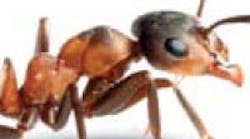You don’t have to be a rocket scientist to understand basic piezotechnology mechanics: If you place an electric field over a piezo crystal, it changes shape. Simple and reliable, one new linear motor based on these piezos operates like the locomotion of an insect.
The motor is one solid piece shaped with multiple legs that can elongate as well as bend sideways. Called Piezo LEGS by its developer, the unit moves incrementally by synchronizing the movement of each pair of its four legs, just as an animal does. Even if the motor is moving incrementally in the nanometer range it's also quick, taking thousands of steps per second to cruise along at several centimeters per second. Different units produce one to several hundred Newtons of pulling force. A motion system based on this actuator normally requires five parts: piezomotor, power supply, control electronics, mechanical interface, and (if it's a closed-loop setup) a position sensor.
Another version moves more like a worm. Called PiezoWave motors, these consist of two piezo elements that vibrate with an ultrasonic frequency when activated electrically, causing drive pads to move elliptically with bending of the piezo elements. The drive pads push on either side of the drive rod to create linear movement.
Originally developed for handheld devices, the PiezoWave motor is now at work in electromechanical door locks and advanced toys and cameras. Its small size and motion dynamics also offer an advantage in medical applications. Developed in Sweden by researchers of Uppsala University, they're produced nearby at PiezoMotor AB, now an OEM manufacturer.
Piezo applications abound: Mobile phones and digital cameras use piezotechnology for zoom and auto focus functionalities. Computer hard disks are produced with this technology for higher-density information packing and shorter access times. Some inkjet printers also use piezotechnology to support and fine-tune printing. Medical applications, such as keyhole and non-invasive surgery and point-of-care devices also make use of piezo components for fine-tuned positioning, measuring, and motion with precision to a single nanometer.
In Comparison
Motors based on piezotechnology are more straightforward than conventional electromagnetic motors. They direct drive, so rotor, stator, and ball bearings are eliminated, and there's no need to convert rotational movement or mechanical transmission. Piezo material does not wear, and compared to traditional dc motors of the same size, piezomotor drive electronics are low cost. Too, dc motors get more expensive as they get smaller, but piezomotors do not.
For more information, visit micromo.com or call (800) 807-9166.





